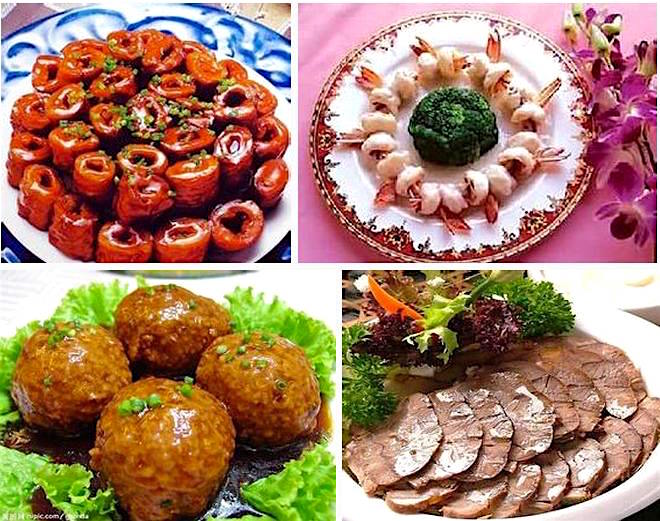While you may not have directly heard of Shandong-style cuisine, chances are you will have felt its influence. As one of the oldest styles in northern China, it has had a direct and palpable impact on other well-known styles of Chinese cuisine, such as that of Beijing and Tianjin. It is held in such high regard that it is not only considered one of the Eight Great Culinary Traditions of Chinese Cooking, but is regularly shortlisted as one of the top four. Its venerable history dates all the way back to the Spring and Autumn Period (c. 771-476 BC), when Shandong as a province had yet to exist and the region was split into two vassal states: the State of Qi and the State of Lu.
The style is often referred to as Lu Cuisine, since the State of Lu was home to Shandong province’s most revered citizen, the great philosopher Confucius. Although Confucius is most renowned for his teachings on morality and education, he wasn’t above philosophising about food! In his Analects, he states: “Do not consume food which looks spoiled, smells spoiled, is out of season, is improperly butchered, or is not made with proper seasoning”. This may seem like common sense now, but over 2,000 years ago food hygiene was still a mystery to the citizens of Lu!
His statements indicate that, all those years ago, the people of Shandong province had already achieved a certain level of refinement with regards to food preparation. However, much of modern-day Shandong cuisine was developed from the Yuan Dynasty (1271-1368) onwards. The style can be roughly split into three sub-styles: the seafood heavy Jiaodong-style along the Jiaodong Peninsula; the soup-centred dishes of the inland Jinan-style; and the elaborate banquets of Confucius’ Mansion cuisine. While these sub-styles tend to differ in their preferred ingredients, they share many similar characteristics when it comes to preparation and flavour.
Liberal use of seasonings such as onions, spring onions, and garlic endow many signature dishes with their distinctive pungency, while a serious dose of salt and soy sauce add a smack of saltiness. Yet Shandong’s star seasoning will always be its vinegar, which is made using centuries-old recipes and traditional local methods. It is much darker and more complex than other types of Chinese vinegar, and is so beloved by the locals that some of them even drink it on its own!
These seasonings may sound a little overbearing, but the main aim of Shandong cuisine is to capture the natural colour, taste, and essence of the main ingredients. To this end, over 30 different cooking methods are deftly used in order to maximise the potential of each ingredient. The most popular cooking methods are known respectively as “bao” and “zha”. The “bao” technique involves allowing oil to boil at an extremely high temperature before tossing the ingredients into the wok and quickly stir-frying them.
The heat of the oil means that the ingredients are slightly singed, but their natural flavour is locked in. Once the ingredients are fully cooked, the oil is removed and seasonings are added, although sometimes the oil will be incorporated into the dish’s sauce. The “zha” technique, on the other hand, is another frying method where meat is covered in flour and then stir-fried to make it wonderfully crisp on the outside but tender and flavourful on the inside.
Dezhou Stewed Chicken (德州扒鸡)
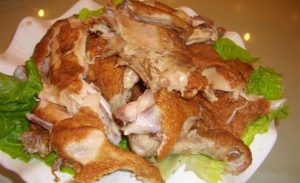 Dezhou Stewed Chicken is essentially exactly what it says on the tin! It originates from the city of Dezhou, its primary cooking method is stewing, and its main ingredient is a plump chicken. Its traditional name of “Dezhou Five-Fragrant Boneless Stewed Chicken” is far more misleading as it’s not boneless and, while it does indeed smell appetising, saying it boasts five fragrances might be a bit ambitious! According to local rumour, the dish was developed by the Deshunzhai Restaurant during the Qing Dynasty (1644-1912). By the 1950s, it was so popular that it was even served to Chairman Mao himself.
Dezhou Stewed Chicken is essentially exactly what it says on the tin! It originates from the city of Dezhou, its primary cooking method is stewing, and its main ingredient is a plump chicken. Its traditional name of “Dezhou Five-Fragrant Boneless Stewed Chicken” is far more misleading as it’s not boneless and, while it does indeed smell appetising, saying it boasts five fragrances might be a bit ambitious! According to local rumour, the dish was developed by the Deshunzhai Restaurant during the Qing Dynasty (1644-1912). By the 1950s, it was so popular that it was even served to Chairman Mao himself.
The dish involves first rubbing caramelised sugar all over a chicken and deep-frying it until its skin turns a crisp golden brown. The chicken is then stewed in an aromatic soup made from soy sauce, Sichuan peppercorns, ginger, cinnamon, aniseed, nutmeg, cloves, fennel, soy sauce, angelica root, black cardamom, dried orange peel, and galangal. Since this dish can take upwards of eight hours to make, it is usually only served in specialist restaurants. While the chicken retains its original shape, it’s so perfectly cooked that the tender meat practically melts off of the bone.
Sweet and Sour Yellow River Carp (糖醋鲤鱼)
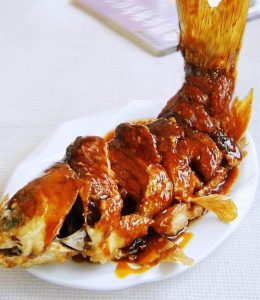 Sweet and Sour Yellow River Carp, which is unsurprisingly made of grass carp fished from the Yellow River, is arguably one of the most iconic dishes in the Shandong canon. It is said that carp from the Yellow River taste different from any other river fish in the country, and it’s been a popular delicacy at imperial banquets for hundreds of years. This particular dish is well-known for its unusual presentation, as the fried fish is served with its tail curved up in the air. This is to give the illusion that the fish has been caught jumping out of the water!
Sweet and Sour Yellow River Carp, which is unsurprisingly made of grass carp fished from the Yellow River, is arguably one of the most iconic dishes in the Shandong canon. It is said that carp from the Yellow River taste different from any other river fish in the country, and it’s been a popular delicacy at imperial banquets for hundreds of years. This particular dish is well-known for its unusual presentation, as the fried fish is served with its tail curved up in the air. This is to give the illusion that the fish has been caught jumping out of the water!
To make Sweet and Sour Yellow River Carp, incisions are made along a whole carp to ensure that the skin remains crispy and the flesh stays moist when it is breaded and deep-fried. Before it is fried, the fish is seasoned with pepper, salt, and soy sauce to give it a pleasant tang. Meanwhile, the sweet and sour sauce is made by mixing vinegar and sugar with ginger, spring onions, Shaoxing rice wine, and soy sauce. The fish is fried first and then removed from the pan when its scales have turned a rich golden brown. The sauce is then added to the pan and cooked at a medium heat for approximately one minute before the fish is re-added and stirred to thoroughly coat it in the sauce. The sweet, tangy sauce complements the soft and subtly flavoured flesh of the fish beautifully, resulting in a dish that is both light and flavourful.
Nine Procedure Large Intestines (九转大肠)
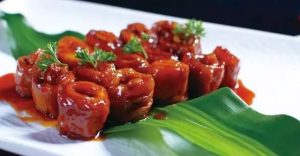 When it comes to Chinese cuisine, you should never judge a dish by its name! Although Nine Procedure Large Intestines may not sound like the most appetising of meals, it has been a wildly popular staple in Shandong province since the Qing Dynasty. A long strip of pig’s intestines is first cleaned, prepared, and boiled so as to remove the unwanted odour of offal. Once they are soft and tender, the intestines are removed from the boiling water and cut into small sections before being deep-fried until they are deliciously crispy.
When it comes to Chinese cuisine, you should never judge a dish by its name! Although Nine Procedure Large Intestines may not sound like the most appetising of meals, it has been a wildly popular staple in Shandong province since the Qing Dynasty. A long strip of pig’s intestines is first cleaned, prepared, and boiled so as to remove the unwanted odour of offal. Once they are soft and tender, the intestines are removed from the boiling water and cut into small sections before being deep-fried until they are deliciously crispy.
The dish’s sauce is made by frying a mixture of onion, garlic, and ginger in a wok until it becomes aromatic. From there, chicken broth, soy sauce, salt, sugar, Shaoxing rice wine, and vinegar are added to give the sauce depth. Finally, the pork intestines are stir-fried in the sauce and garnished with coriander to serve. The name “Nine Procedure Large Intestines” has absolutely nothing to do with the cooking method, and in fact refers to the Nine Procedures in Taoism used to refine the pills of immortality. In other words, scholars considered this dish so difficult to perfect that they likened it to man’s never-ending quest to achieve eternal life!
Braised Sea Cucumber (葱烧海参)
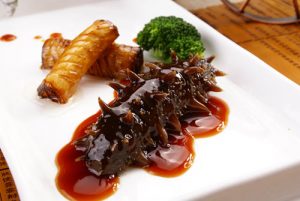 As a coastal province, seafood plays a major role in Shandong cuisine. Braised Sea Cucumber is one of the classic dishes in the Shandong canon and is emblematic of the locals’ love for seafood. Although the sea cucumbers are phenomenally fresh and have a rich umami flavour, the real power behind this sumptuous dish comes from the sauce. This sauce is made simply by caramelising a mixture of chopped onions, spring onions, and soy sauce in oil and sugar. Meanwhile, the sea cucumber is gently braised in chicken stock, salt, and Shaoxing rice wine.
As a coastal province, seafood plays a major role in Shandong cuisine. Braised Sea Cucumber is one of the classic dishes in the Shandong canon and is emblematic of the locals’ love for seafood. Although the sea cucumbers are phenomenally fresh and have a rich umami flavour, the real power behind this sumptuous dish comes from the sauce. This sauce is made simply by caramelising a mixture of chopped onions, spring onions, and soy sauce in oil and sugar. Meanwhile, the sea cucumber is gently braised in chicken stock, salt, and Shaoxing rice wine.
Once the sauce is prepared and the sea cucumber is thoroughly cooked, the two are mixed in a pan along with a hearty helping of ginger and brought to a boil before starch is added to thicken the sauce. While this dish can look a little unusual and somewhat unappetising, the smooth texture of the sea cucumber is perfectly complemented by the sour tang of the sauce, offering up a taste sensation that is sure to confuse and delight your taste-buds in equal measure.
Braised Abalone with Shells (扒原壳鲍鱼)
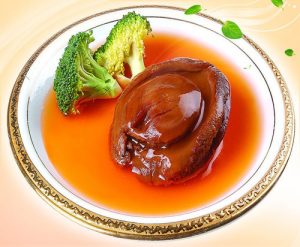 Abalone is another aquatic favourite in Shandong province that we rarely see in Western cuisine. In this signature dish, the abalone is served with its shell to give diners the impression that they’re sampling a little bit of the ocean. The abalone itself is relatively bland, but absorbs the light sauce beautifully and provides a wonderfully chewy texture. In order to make the sauce, an aromatic mixture of Shaoxing rice wine, rice vinegar, sugar, salt, ginger, garlic, spring onions, chicken stock, and starch is brought to a boil and then quickly removed from the heat.
Abalone is another aquatic favourite in Shandong province that we rarely see in Western cuisine. In this signature dish, the abalone is served with its shell to give diners the impression that they’re sampling a little bit of the ocean. The abalone itself is relatively bland, but absorbs the light sauce beautifully and provides a wonderfully chewy texture. In order to make the sauce, an aromatic mixture of Shaoxing rice wine, rice vinegar, sugar, salt, ginger, garlic, spring onions, chicken stock, and starch is brought to a boil and then quickly removed from the heat.
The juicy slices of abalone are fried in hot oil with chopped chilli peppers for approximately two minutes, until the abalone is fully cooked. The oil is then removed from the pan and the abalone is re-added along with the sauce, which is swiftly brought to a boil. Once the dish is piping hot, it’s taken off the heat and served immediately. The light sauce virtually glances off of the tongue, while the thick slices of abalone provide you with something to really sink your teeth into!
